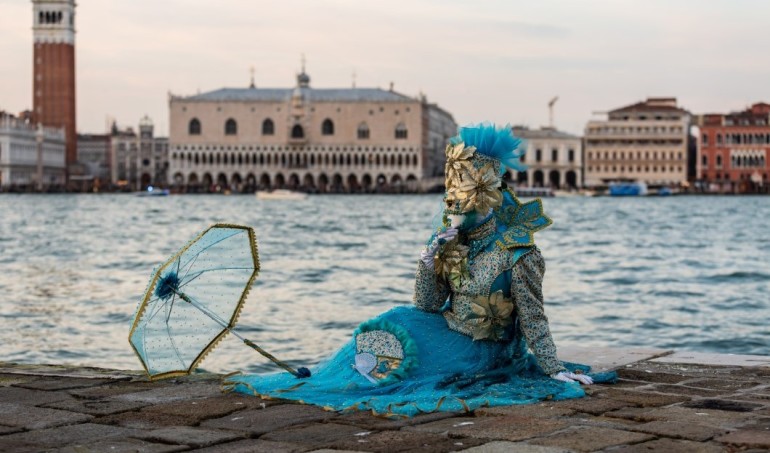Sponsored Listings:
The threat of coronavirus did not skip Italy, nor Venice. The streets of the city look emptier than usual. The decrease in visitors is relative, although the Carnival approaches: a festival that every year reports a surge in mass tourism. This year, the empty streets are worrying local businesses.
While the Venice Carnival without mass tourism may sound tempting for the would-be visitors, the tourism companies are not so thrilled. They actually start to panic.
According to the forecasts of Stefania Stea, Vice President of the Venetian Hoteliers Association, “…the reservations reach 70 or 80% during the three carnival weekends, while numbers are inferior during the week despite the fact that prices have been lowered.”
Venice is a city accustomed to hanging a ‘no vacancies’ sign on the front of hotels, so a slight crisis worries the hotel managers. A few days ago, the association invited about 40 foreign correspondents, in an attempt to repair an image that has been damaged in recent months.
In fact, the worst part is not the Wuhan virus crisis, but the floods of a few months ago. On November 12, a rainstorm raised the tides above the usual. For Venice, this phenomenon is something ordinary, known as ‘acqua alta’ [“high water”], but that day the water level reached 1.87 meters, just below the record of 1.94 meters set in 1996. This means that St Mark’s Square, built in the lowest area of the city, stays covered by more than one meter of saltwater. The images of the esplanade converted into a large pool had such an impact that some tourists called tour operators and agencies asking if the city was already dry.
While the tides returned to the channel that same afternoon, people kept calling for several days and many of them cancelled their bookings. Almost 50% of hotel reservations collapsed.
The city council estimates that damage to houses and businesses is valued at 400 million euros. One of the most emblematic places, St Mark’s Basilica, was left completely flooded as water entered through its crypt. “The church has been here for 1,000 years, it’s [like] an old lady that aged 50 years in just a day,” says Pierpaolo Campostrini, technical manager of the temple.
Local authorities now rely on the Government to allocate financial aid as soon as possible. The flood was followed by the Wuhan virus outbreak, which has also affected tourism revenues. “The impact of the virus is lower in Venice, since the number of Chinese tourists in the city is quite small,” said the mayor, Luigi Brugnaro.

Official figures of the Venetian Administration show that Chinese visitors are fifth by the number of visitors. So in a way, they’re not a significant market. Their stay is shorter than that of citizens of other countries, so many of them fall into a category that Italians call ‘mordi e fuggi’ (“bite and run”). Most Chinese visitors arrive with tour packages that make Venice a mandatory stop rather than a must-see destination of Italy or through large cruises.
Luigi Brugnaro, a Venetian entrepreneur who in the last elections was supported by a coalition of right-wing parties, says he “more than anyone” is interested in “ending mass tourism.” At the moment, his office has introduced a 3-euro tax to all visitors who do not spend the night in the city, has pushed for a law so that floors can only be used as tourist apartments for up to 100 days a year, and is discussing the possibility of cruise ships arriving in the city by an alternative port and not directly through St Mark’s Square.
However, the reality is that Venice’s population barely exceeds 52,000 people, less than a third of what the city had in the mid-twentieth century. For the mayor, it is only due to “aging citizens, something that happens in all major European cities.” On the other hand, the most critical of Brugnaro’s administration says that the tourist model that the city has developed is responsible for that, especially the lack of recognition from the authorities to a mechanism that actually brings in money.
“If one wants to truly transform Venice into a theme park, [then let] more tourists come,” says Tommaso Cacciari of the ‘Committee’ against large ships in Venice. “Ships are getting bigger and bigger, so they are incompatible with European ports built in the 18th and 19th centuries. So the only solution is to adopt measures like in Miami, which moved its port [away] from the city, and keep the cruise ships outside the Venetian Lagoon,” he says. Different reports estimate that Venice receives between 20 and 30 million tourists every year, which also affects the sustainability of an already fragile city.
Venice claims to be the city that recycles most of all Italy, and those living in its historic center are proud to always rise above adversities such as the ‘acqua alta’. Now, the effect of the tides has lowered the wave of tourists. What is not so clear is if everyone is satisfied with this new climate.
Source: tourism-review.com










